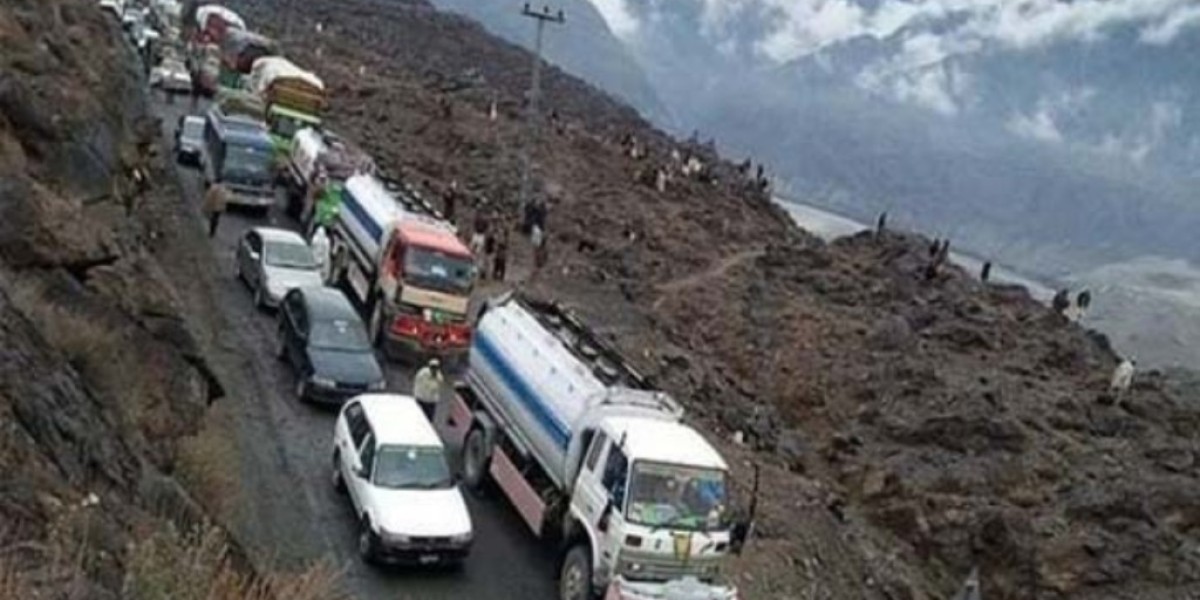Causes of the Congestion
The heavy traffic congestion was caused by several factors:
Roadblocks and Landslides: The area is prone to landslides, especially during the monsoon season. The mountain soil was loosened by recent heavy rains, causing a significant landslide that blocked the highway. Authorities' efforts to clear the debris were hampered by incessant rain, further delaying the road's recovery from schedule.
Inadequate Infrastructure: Despite its importance, the Karakoram Highway has inadequate infrastructure. Especially during rush hours, the narrow and winding roads are ill-equipped to handle heavy traffic. The situation is further aggravated by the lack of alternative routes, forcing passengers to wait.
High Volume of Traffic: Due to the highway's significance as a major trade route between Pakistan and China, there is a constant flow of heavy vehicles. Additionally, the scenic beauty of the region attracts many tourists. Congestion becomes inevitable when commercial, local, and tourist traffic gathers on the same route, especially when unexpected obstacles occur.
Limited Emergency Response: The remote location of the Karakoram Highway means that emergency response teams take longer to reach the scene of any incident. In this case, the long-standing traffic jam was significantly aggravated by the delay in deploying equipment and personnel to remove the landslide.
Impacts on Travelers and Surrounding Communities
Travelers and surrounding communities were significantly affected by the traffic jam at Zero Point, Chilas:
Travel Disruptions: Hundreds of tourists, elderly individuals, and families with children were stranded for hours. Their plight was compounded by the absence of basic amenities such as water, food, and toilets. Due to inclement weather, many passengers were forced to spend the night in their vehicles.
Economic Losses: The suspension of traffic on the Karakoram Highway, which is a vital trade route, resulted in significant economic losses. Perishable goods like fruits and vegetables were particularly affected, leading to financial losses for traders. In addition, supply chains were disrupted due to delays in the transportation of goods, impacting both local and metropolitan businesses.
Local Communities: Local communities along the highway rely on it for their daily commute and access to essential services. The traffic jam disrupted their routines, making it difficult for them to reach workplaces, medical facilities, and schools. Additionally, the delivery of supplies to these remote areas was hampered by the prolonged traffic jam.
Response and Mitigation Efforts
When the traffic jam was reported, authorities mobilized resources to address the problem. However, the response demonstrated the need for more effective emergency management strategies:
Deployment of Machinery: Heavy equipment, including bulldozers and excavators, was deployed to remove the landslide and restore traffic flow. Despite continued rain and difficult terrain, persistent work eventually resulted in the partial opening of the highway.
Traffic Control: After the road was cleared, law enforcement agencies were involved in traffic control to ensure the proper movement of vehicles. Additional staff were dispatched to assist and guide passengers.
Communication: Authorities communicated with passengers through various channels, including social media, to update them on the situation and offer advice on alternative routes whenever possible. This helped manage the expectations of those stranded and ease panic.
Solutions for the Future
The massive traffic jam at Zero Point, Chilas, highlights the need for long-term solutions to avert future incidents like this. Several options can be considered:
Infrastructure Improvement: The Karakoram Highway needs urgent upgrades to accommodate the increasing volume of traffic. Constructing alternative routes, widening the road, and reinforcing sections prone to landslides can help reduce congestion and improve traffic flow.
Early Warning Systems: Early warning systems for landslides or other natural disasters can help with timely traffic management and evacuations. Real-time data provided by these systems enable authorities to take preventive measures to avoid road congestion.
Emergency Response Teams: Establishing well-equipped emergency response teams at strategic locations along the highway can significantly reduce response times. These teams should have the necessary hardware and personnel to quickly address any incidents.
Community Engagement: Involving local communities in disaster response and preparedness plans can enhance resilience. Awareness campaigns and training programs can equip residents with the knowledge and skills necessary to respond effectively to emergencies.
Traffic Flow Management: Implementing traffic flow management measures, such as staggered timing for heavy vehicles and dedicated lanes for different types of traffic, can help manage congestion. Additionally, promoting alternative modes of transportation, such as rail, can reduce the burden on the highway.
Conclusion
The massive traffic jam at Zero Point, Chilas, on the Karakoram Highway highlights the challenges faced by this vital infrastructure. While the immediate response helped alleviate the situation, there is a clear need for long-term solutions to prevent similar incidents in the future. Upgrading infrastructure, implementing early warning systems, enhancing emergency response capabilities, and engaging local communities are essential steps toward ensuring the resilience of the Karakoram Highway. As the region continues to develop and attract more travelers, addressing these challenges will be crucial in maintaining the vital link between Pakistan and China and ensuring the well-being of the local communities.









